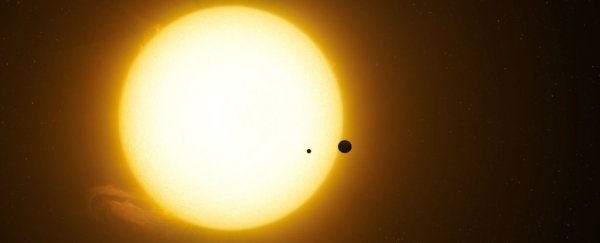The first ever tentative detection of a moon outside our Solar System has been called into question. In follow-up analyses of the data, astronomers have failed to detect the faint dip in the light of a star that would indicate the presence of a planet's moon passing by.
In separate papers, two teams performed independent analyses. One found that the exomoon detection signal was likely a blip in the original data. The other found a similar solution to the initial analysis, but cautioned that it was not a conclusive detection of an exomoon.
A confirmed discovery of an exomoon would be a big deal. Astronomers suppose there must be a lot of them out there - after all, the Solar System has way more moons than it does planets, so theoretically they should be pretty common.
But detecting them is easier said than done. We can detect exoplanets based on their effects on the star they orbit, usually the slight dimming of starlight as the planet passes between us and its star (called a transit), or a very faint Doppler shift - a change in the light's wavelength - based on the planet's gravitational effect on the star.
When trying to detect exomoons, however, there are two big problems. The first is that exomoons would be much smaller than the exoplanets they orbit, meaning any effects we can observe would also be much smaller. The second issue is that astronomers need to be able to separate any supposed exomoon effects from the effects of its host planet.
Last year, Alex Teachey and David Kipping of Columbia University announced that they had done just that. They had detected little dips and wobbles above and beyond a normal planet transit in data from the planet-hunting Kepler space telescope.
Follow-up observations with the Hubble Space Telescope seemed to confirm the result, showing a second dip directly after the planet's transit.
The astronomers called the candidate exomoon Kepler-1625b-i, orbiting a Jupiter-sized exoplanet called Kepler-1625b, which in turn orbits a yellow, Sun-like star called Kepler-1625. The entire system is located around 8,000 light-years away.
According to the pair's calculations, the exomoon was about the size of Neptune, which would make it also a gas giant - the first gas giant moon ever seen, raising interesting questions about moon formation.
But, with the result now failing replication, maybe we don't have a Neptmoon on our hands after all.
Laura Kreidberg of the Harvard-Smithsonian Centre for Astrophysics and colleagues conducted a reanalysis of the data using an independent technique, and found that the resulting transit light curve was well within the parameters for a transit-only model.
"We compare our results directly with the original light curve from Teachey & Kipping (2018), and find that we obtain a better fit to the data using a model with fewer free parameters (no moon)," they wrote in their paper.
"We discuss possible sources for the discrepancy in our results, and conclude that the lunar transit signal found by Teachey & Kipping (2018) was likely an artefact of the data reduction."
Meanwhile, René Heller of the Max Planck Institute for Solar System Research and fellow researchers were conducting their own analysis. They ran the Kepler and Hubble data through simulations, with models that included planet-only and planet-moon simulations, and returned so many matches that they could extract no meaningful conclusions.
"Although we find a similar solution to the planet-moon model to that previously proposed, careful consideration of its statistical evidence leads us to believe that this is not a secure exomoon detection," they wrote in their paper.
That doesn't mean there isn't an exomoon. Basically, there's a big ol' question mark over Kepler-1625b-i - which, to be fair, was actually only ever a candidate moon, not a confirmed one.
In a new paper, Teachey, Kipping and others have recrunched their numbers, quantifying that the probability the light dips were caused by a Neptune-sized planet (rather than a moon) is less than 0.75 percent, and demonstrating that Kepler-1625 is a quiet star that is unlikely to introduce "false-positive dip-like features".
They also responded to Kreidberg's analysis, noting that the method used by her team was just as likely to have erased the exomoon as their own was to have introduced one.
There remains one more piece of evidence still pointing to the possible existence of an exomoon. In the data, the planet started its transit 1.75 hours earlier than expected - consistent with something gravitationally tugging on it. Like, say, a huge moon.
All three papers concurred that, yes, this early transit happened.
So Kepler-1625b-i is still very much on the table. Perhaps TESS, Kepler's more high-tech successor, will be able to shed some more light on the matter.
The three papers have been published, in order of mention, here, here and here.
H/T: Science News
